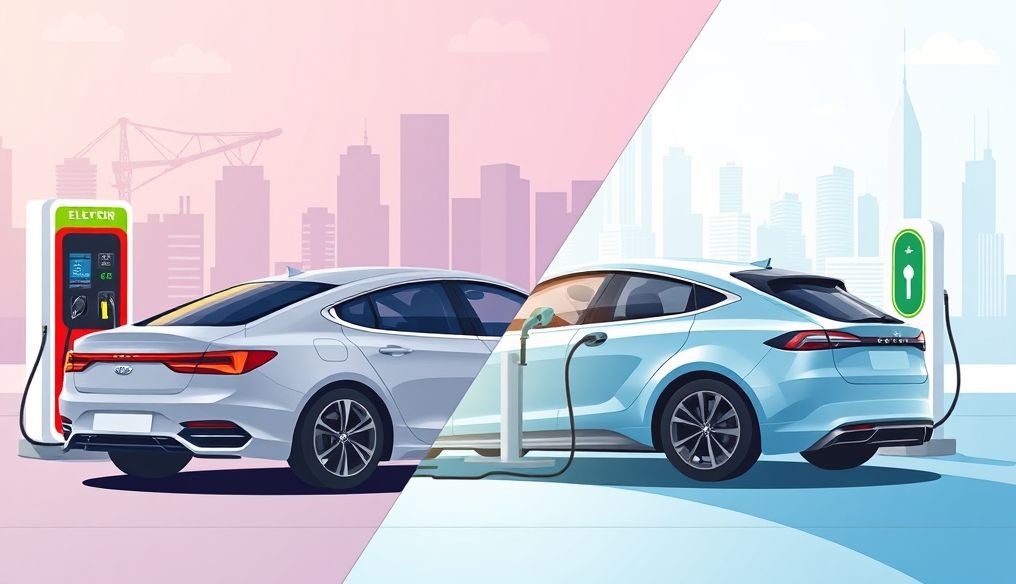Introduction: The Future of Sustainable Transportation
The automotive world is undergoing a radical transformation towards more sustainable and environmentally friendly technologies. Hybrid and all-electric cars are the main players in this transformation, offering alternatives to traditional cars that rely on internal combustion engines. With increasing interest in reducing carbon emissions and improving air quality, it has become necessary to understand the fundamental differences between these two types of cars to make an informed decision when purchasing.
1. Definition of Hybrid Vehicles
Hybrid vehicles combine an internal combustion engine (usually gasoline-powered) with an electric motor. The electric motor assists the traditional engine, reducing fuel consumption and emissions. There are different types of hybrid vehicles:
- Mild Hybrid: The electric motor provides limited assistance to the traditional engine, and the car cannot run on electricity alone.
- Full Hybrid: The car can run on electricity alone for short distances, especially at low speeds.
- Plug-in Hybrid: The car's battery can be charged from an external source, allowing for longer distances to be covered on electricity only compared to a full hybrid.
2. Definition of Battery Electric Vehicles (BEV)
All-electric cars rely entirely on electricity as a power source. There is no internal combustion engine; instead, the car relies on a large battery to power the electric motor. The battery is charged from an external source.
3. Power Source: Fuel vs. Electricity
Hybrid Vehicles: Rely on both fuel (gasoline or diesel) and electricity. Fuel is filled at a gas station, while the battery is charged either by the traditional engine (in mild and full hybrids) or by an external source (in plug-in hybrids).
All-Electric Vehicles: Rely only on electricity. The battery is charged by connecting the car to an electrical source, such as a home charging station or a public charging station.
4. Drive System: Internal Combustion Engine and Electric Motor vs. Electric Motor Only
Hybrid Vehicles: Use a complex drive system that combines the internal combustion engine and the electric motor. The electric motor can assist the traditional engine in accelerating or driving at low speeds, reducing fuel consumption. In some cases, the car can run on electricity alone for short distances.
All-Electric Vehicles: Use one or more electric motors to drive the wheels. The electric motor provides instant torque, making acceleration quick and smooth.
5. Driving Range: Distance that Can Be Covered Before Refueling or Charging
Hybrid Vehicles: Have a longer driving range compared to all-electric cars, as they can rely on fuel if the battery runs out. The average driving range for hybrid cars ranges from 500 to 1000 kilometers.
All-Electric Vehicles: The driving range depends on the size of the battery and the efficiency of the electric motor. The driving range for all-electric cars ranges from 200 to 600 kilometers, but this range is increasing with technological advancements.
6. Emissions: Lower vs. Zero
Hybrid Vehicles: Produce fewer emissions compared to traditional cars that rely solely on internal combustion engines. However, they still produce emissions, especially when relying on fuel.
All-Electric Vehicles: Produce no direct emissions while driving. All-electric cars are a significantly more environmentally friendly option, especially if the electricity used to charge the battery comes from renewable sources.
7. Purchase and Operating Costs
Hybrid Vehicles: Usually cost less than all-electric cars to purchase. However, the cost of fuel may be higher in the long run.
All-Electric Vehicles: Usually cost more to purchase, but the operating cost is lower due to the lower cost of electricity compared to fuel. Additionally, there may be tax incentives or government support for purchasing electric cars in some countries.
8. Charging and Refueling Infrastructure
Hybrid Vehicles: Can be refueled at any gas station, making them convenient to use in areas that lack charging infrastructure.
All-Electric Vehicles: Require charging infrastructure, which is still under development in many areas. However, the number of public charging stations is constantly increasing, and the car can be charged at home using a home charger.
9. Maintenance
Hybrid Vehicles: Require more complex maintenance due to the presence of both the internal combustion engine and the electric motor.
All-Electric Vehicles: Require less maintenance, as there is no internal combustion engine or transmission. However, replacing the battery can be expensive.
10. Performance and Driving Experience
Hybrid Vehicles: Offer good performance and fuel economy. The driving experience is similar to traditional cars.
All-Electric Vehicles: Offer quick and smooth acceleration and quiet driving. The driving experience is different and enjoyable for many.
Conclusion: Choosing the Right Car for Your Needs
Choosing the right car depends on your needs, budget, and priorities. If you are looking for a fuel-efficient car that offers a long driving range, a hybrid car may be the best option. However, if you are looking for an environmentally friendly car that produces no emissions and enjoys a unique driving experience, an all-electric car may be the ideal choice.




